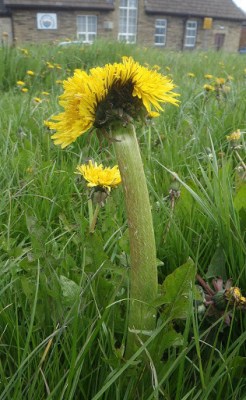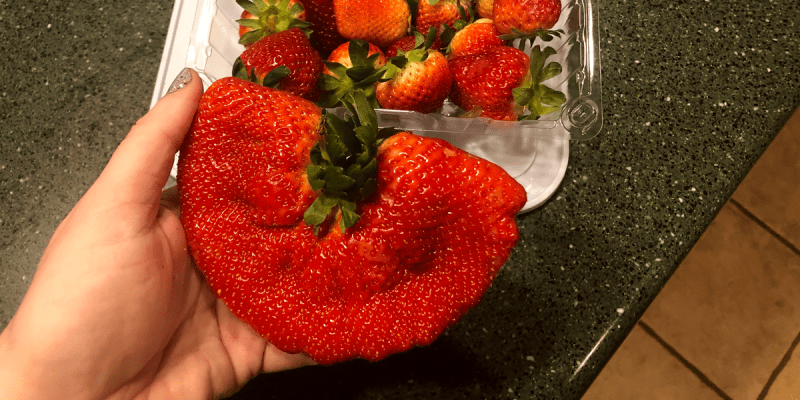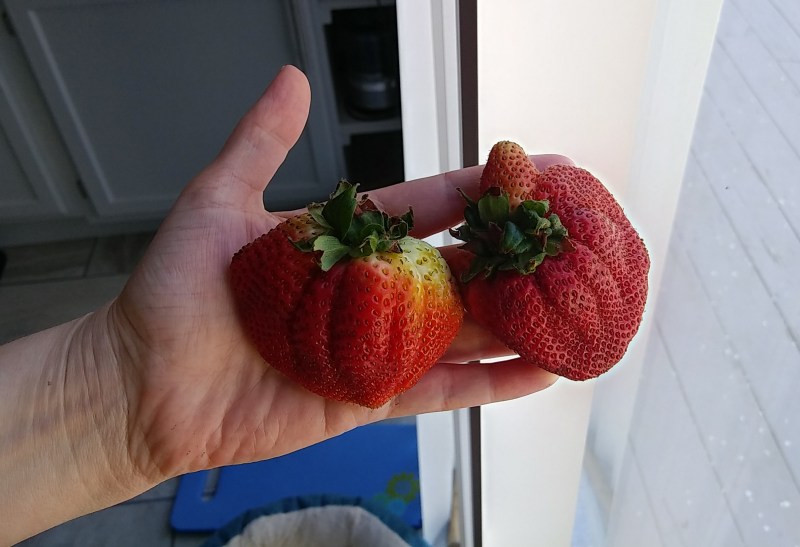The other day, I saw this gigantic mutant strawberry on reddit that looked like it had either been growing in a radiation zone, hitting the gym regularly, or sprinkled with magic dust. I immediately felt more than mildly interested in this phenomenon, which is called fasciation.
As it turns out, fasciation is fairly rare occurrence that nonetheless occurs in a wide variety of vascular plants. These mutant strawberries may be a bit unnerving to look at, but they are totally safe to eat. The only problem is that you’re more likely to come across a fasciated dandelion or daisy out in the wild than a strawberry or pineapple at the grocery store because the so-called ugly produce tends to be weeded out.
Fasciation is essentially unregulated tissue growth that occurs when the apical meristem, better known as the growing tip of the plant strays from shooting upward in cylindrical fashion and instead splays out flat, resulting in ribbon-like plant stems, elongated or multiple flower heads, and semi-circular strawberries.

Although fasciation tends to present as a flattened main stem, the phenomenon can occur nearly anywhere in the plant — the root, stem, leaves, flower heads, or fruit. It can be localized to just one area, or it affect the entire plant.
Fasciation gets compared to cancer because it has a number of causes and ways of expression, but it’s not quite as harmful or scary. Some races of plants exhibit extreme expression of fasciation. While it’s not fatal, it’s also not ideal, because the condition can result in broken tissues, distorted organization, and a decrease in fertility.
Fasciation: How does it work?

Fasciation has many causes both internal and external. Internally, it happens because of a hormonal imbalance in the growth cells, a bacterial or viral infection, or a random genetic mutation. There are also environmental causes, like chemical exposure, cold and frost exposure, or fungi, mite, and insect attacks.
The wonder of fasciation knows no geographical, climatic, ecological, or taxonomical bounds among vascular plants. It equally affects annuals, biennials, and perennials; woody and herbaceous plants; shrubs, trees, and vines. Although fasciation can occur in any vascular plant, it is quite common in the rose (includes strawberries), legume, sunflower, and cactus families, and is often found among dandelions and snapdragons.
Some vascular plants are prone to fasciation and prized for it, like the cockscomb (Celosia cristata) flower. A few fasciated flora have even become objects of reverence, like the Virgin Mary appearing on a slice of toast. There was once a fasciated pumpkin vine growing in South India. The twenty-foot-long fasciated portion drew huge crowds of people to worship it, believing the vine to be an incarnation of King Cobra or Naga Sarpa, messenger of the god Vishnu.
This spring, I’ll be looking high and low for abnormal dandelions and daisies. I’ve already started scouting the produce at the grocery store for giant strawberries and found these two in the same box. Won’t you join me? We’re probably more likely to find fasciated fruits or flowers than four-leaf clovers.


















Some “races” of plants? Surely that should be species?
I was curious too, looks like it is a biology term I was just unfamiliar with: https://en.wikipedia.org/wiki/Race_%28biology%29
Landrace is a common term and has no negative connotation in plant biology.
I tend to not like the term used with humans, and now that I think about any mammals, and think better to use instead of race to more accurately use traits where: race = (breed + cultural) or (genotypical + phenotypical) or (natural + nurtured)
I got a fasciated tomato this year. The plants were growing since Oct in a small container and it got frost bit. Transplanted them and they exploded the stem got wide and then got a bloom that was huge, I was hoping it was going to make a crazy tomato and it did. It looks like 3 or 4 grown together! Can’t wait to eat it!
Photos, or it didn’t happen!
B^)
Before, not after.
Yes, thanks for mentioning that!
I got one like that some years ago: https://slashhome.se/p/gallery/?f=gallery/Misc/IMG_5296.JPG It was pretty neat and still tasted good. :)
I was under the impression that beefsteak/”giant” tomatoes are fasciated. Regular tomatoes seam to have a radial webbing dividing the inside, but beefsteak tomatoes seem to have their interior space divided up into random pockets by this webbing.
That or maybe they’re just a species that we haven’t artificially selected for looks and productivity
Nope, they’re fascinated. Also look at “beef heart” tomatoes
Those strawberries are tasteless though! You’ve never had a real strawberry unless you’ve had one from Québec in June! Absolutely delicious, and the taste doesn’t even come close to comparing to the strawberries pictured in the article. Our strawberries turn dark red inside and out! None of these white/green spots that make a strawberry hard and without juice.
I beg to differ. I got some pink pale strawberry that I hybridized with wild ones and are absolutely delicious and very resistant. But low yield.
I’ll second that. Strawberries of any kind in the supermarket are tasteless – as are many other supermarket fruits including grapes and cherries.
Most fruit and vegetables bound for markets via logistics (shipping from the source, to a central distribution point, to local distrubution, and finally to the local market) are picked well before they are ripe, so that the produce is not spoiled and still has many days of shelf life while waiting for purchase and consumption. The time from farm to your shopping basket can range from several days to more than a month.
Nothing like a neighborhood fruit stand where you can buy produce in the same week (and possibly day) it was harvested, properly ripened, aside from growing your own…
Quebec in June?! No! Real strawberries only come from the Merrimack river valley between 43 0′ and 43 15′ latitude during the window of 12-28 of July except during leap years. Anything else barely compares.
You neglected harvesting them by virgins under a full moon
That’s the other kind of plant… :)
Thanks for the tip. I’ll make it a point to visit Johnson Golden Harvest (412 W River Rd, Hooksett, NH 03106) this July. Fireflies (at night) should be spectacular right about then.
It’s not a real strawberry unless it comes from the Strawbe region of France.
Otherwise it’s just sparkling berry.
lol
Heck, New Hampshire is full of strawberries. I used to harvest them from my lawn before mowing it!
With strawberries, it’s quite simple: the smaller they are, the better they taste. Seriously. But people want giant strawberries for some reason. I only ever buy the small ones.
Mmmmm… Strawberry shortcake after a fried chicken dinner with mashed taters and home grown sweet corn fresh from the garden (or green beans freshly snapped with bacon) .. down on the farm.
Or Scottish strawberries! I only tend to buy strawberries when they’re in season here, the long summer days (55.87° north where I am) make for some amazingly sweet and flavoursome fruit, blood red throughout. To buy them from anywhere else is just a disappointment really.
We had a crazy, flat pumpkin stem last year. Apparently we missed out on the worshiper crowd though.
For crazy pumpkins come to Morton, Ill for the Pumpkin Festival. Crazy large pumpkins and ‘punkin chunking’ . Libbys Libbys Libbys …
“they are totally safe to eat… causes, like chemical exposure, cold and frost exposure, or fungi, mite, and insect attacks.”
Hmmm, pass.
Fasciation is common among legumes? Might be interesting to breed some fasciating legume crops, just imagine feeding a family of 5 with one kidney bean!
Cannabis does this, too. It’s known as polyploidization, and naturally occurs often enough that I see it once in 5 years or so.
Before or after you smoke it?
B^)
fasciation is NOT polyploidization
Polyploidic plants have several sets of chromosomes into each cells.
– This can happen naturally (and not only by plants)
– Almost all commercial cannabis is polyploid
– much of human-selected plants are
In general, while polyploid plants might be more frequently fasciated, polyploidic plants are more productive, bigger fruits…
As a breeder, of humans, I am glad this doesn’t happen to mammals, very often.
Nice work if you can get it. :)
Actually, I think it’s quite common here in the U.S..
Maybe it just seems that way, though since I’m so close to the local Walmart.
I don’t know if this is the same mechanism, but I seem to have 2 sweet pea plants growing from a single seed.
it´s not. It´s just two embryos from one seed, aka twins.
Still looking for the HACK here?
Now we’re just posting about stuff on Reddit and Wikipedia?
Thinking is an inspiration or warm up to cloning the traits maybe? Tissue culture lab was first to come to mind or maybe like some other way.
Hmmm, I wonder how to induce fasciation on my legal marijuana plants….
Totally reminded me of variegation and then wondering if related. https://en.wikipedia.org/wiki/Variegation
With the… let’s say indica (21 USC 802(16)) for those feeling left out States… comments, I was also thinking about cloning the strains to keep the traits if you wanted.
What would be a neat Hack, now that comes to mind, is a DIY Homebrew tissue culture lab or even the range of cloning methods for the range of plants to clone.
We had a daisy like that about 15 years back when i moved to this house, good to know the name for it now ;)
wow never seen fasciation in other plants, but its very “common” to find fasciation (crested) cactus
Can we induce fasciation artificially using chemicals in fruits?